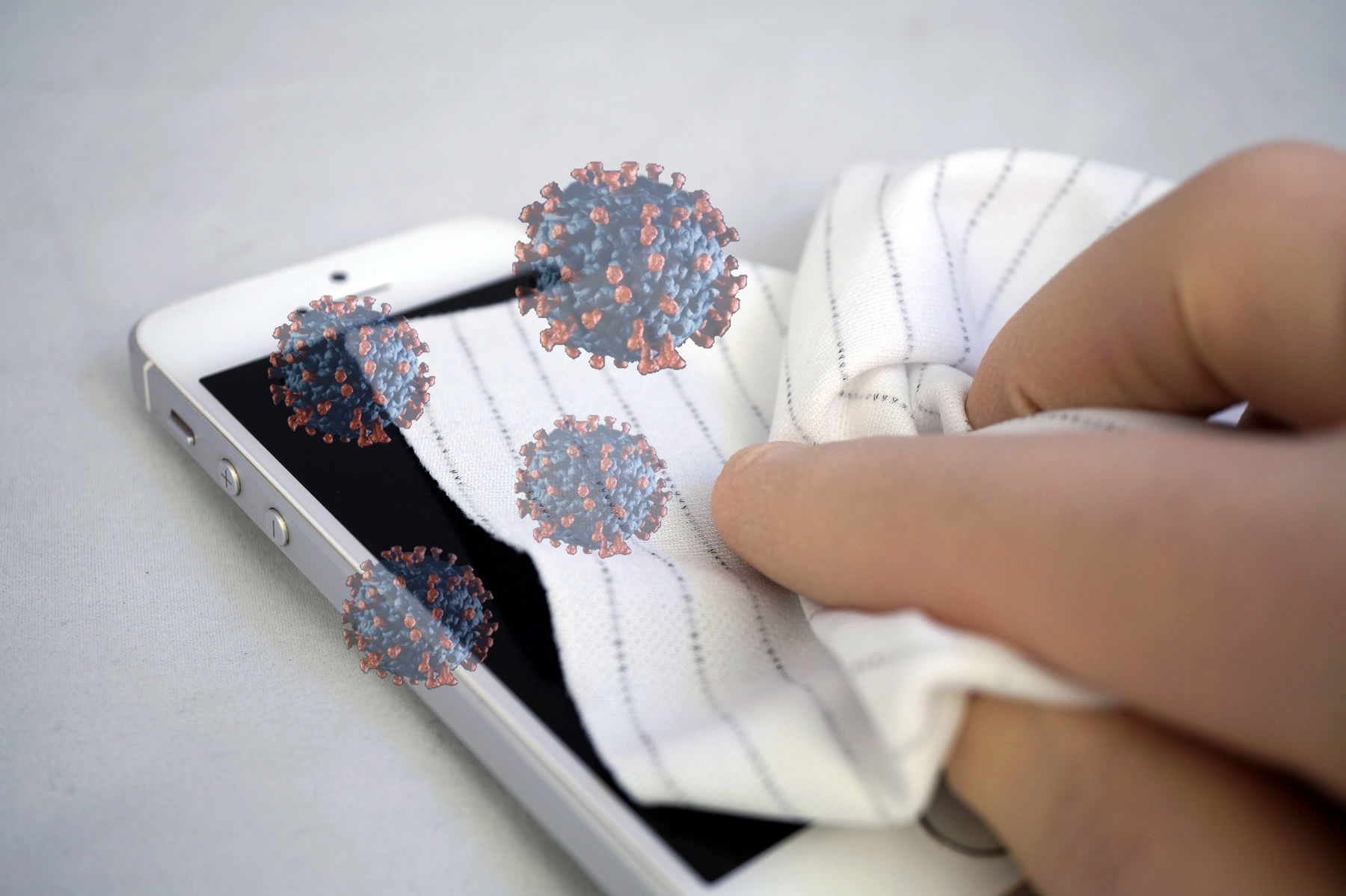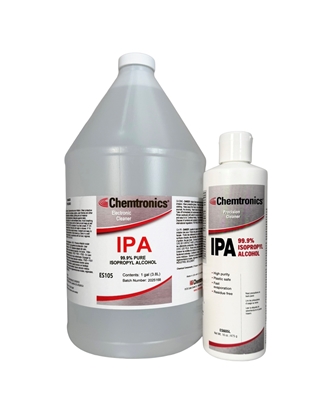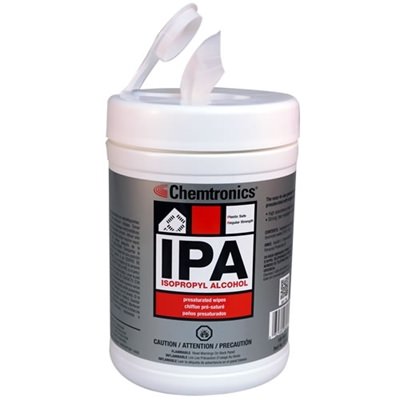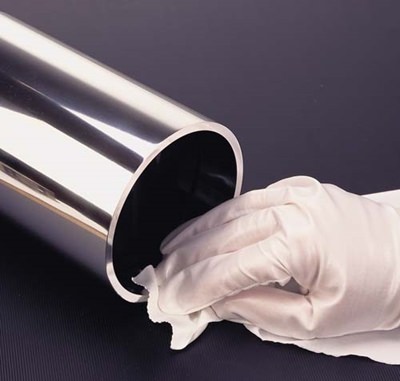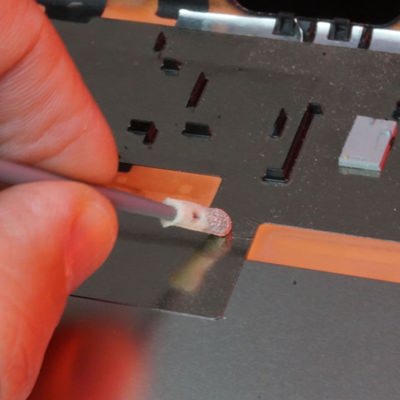The Coronavirus/COVID-19 pandemic has drawn attention to cleaning and disinfecting personal mobile devices. That intuitively makes sense, because we are constantly handling our phones and then pressing them against our face, close to our mouth and nose. The importance of keeping our hands away from our face to avoid infection is now well understood, so it is no wonder a dirty phone is now so repulsive.
Does all this extra cleaning risk damaging these sensitive electronic devices? We take our smart phones for granted, but they are actually marvels of engineering, being economical, sophisticated, miniature, and rugged at the same time. They can take a beating, but there are limits.
In this paper, I combine primary sourcing from the CDC, Apple, and Samsung along with our own high precision cleaning expertise to give you the best practices for cleaning your mobile devices.
Cleaning Versus Disinfecting
First, let’s get our terminology straight. The CDC defines cleaning as “the removal of germs, dirt, and impurities from surfaces. It does not kill germs, but by removing them, it lowers their numbers and the risk of spreading infection.”
So the typical method of cleaning your smart phone with a microfiber cloth (or your shirt sleeve) removes finger prints and may lower the amount of viral contamination on the surface, but doesn’t kill anything.
The CDC defines disinfecting as “using chemicals, for example, EPA-registered disinfectants, to kill germs on surfaces. This process does not necessarily clean dirty surfaces or remove germs, but by killing germs on a surface after cleaning, it can further lower the risk of spreading infection.”
CDC Recommendations for Cleaners
The CDC provides a list of disinfectants [https://www.epa.gov/pesticide-registration/list-n-disinfectants-use-against-sars-cov-2] tested and proven effective for SARS-CoV-2, so presumably also effective on COVID-19. These are a mixed bag of cleaning agents, some of which could be used on mobile devices without harm, but many should not be.
The CDC did provide specific guidance for mobile devices:
“For electronics follow the manufacturer’s instructions for all cleaning and disinfection products. Consider use of wipeable covers for electronics. If no manufacturer guidance is available, consider the use of alcohol-based wipes or spray containing at least 70% alcohol to disinfect touch screens. Dry surfaces thoroughly to avoid pooling of liquids.”
I thought it would be helpful to also review recommendations from two of the largest brands of mobile phones…
Apple’s Guidelines
The following is from Apple’s cleaning guidelines, recently updated to include disinfecting:
Using a 70 percent isopropyl alcohol wipe or Clorox Disinfecting Wipes, you may gently wipe the exterior surfaces of your iPhone. Don't use bleach. Avoid getting moisture in any openings, and don't submerge your iPhone in any cleaning agents.
- Unplug all cables and turn off your iPhone.
- Use a soft, slightly damp, lint-free cloth—for example, a lens cloth.
- Avoid getting moisture in openings.
- Don’t use cleaning products or compressed air.
Your iPhone has a fingerprint-resistant oleophobic—oil repellent—coating. On iPhone 8 and later, the coating is on the front and back. This coating wears over time with normal use. Cleaning products and abrasive materials will further diminish the coating and might scratch your iPhone.
Samsung’s Guidelines
Samsung provided similar guidelines:
Before starting, make sure your device is powered down and unplugged from any power sources. Remove any covers, cases, or accessories as well.
- A lint-free, soft microfiber cleaning cloth is ideal for cleaning your device. You may also use a camera lens cleaning cloth. These are gentle and will not damage your device.
- Gently wipe the front and back of your device with the microfiber cloth. Do not apply too much pressure.
- You should avoid getting excess moisture onto your device; however, you may dampen the corner of the microfiber cloth with a small amount of distilled water.
- You can also use a disinfectant, such as a hypochlorous acid-based solution (containing 50-80ppm) or an alcohol-based solution (containing more than 70% ethanol or isopropyl alcohol). Do not apply these liquid solutions directly to your device; they should be carefully applied to a microfiber cloth instead.
- Avoid using cans of compressed air, as they may damage the surface of your device.
- Do not use spray bleach on your device.
Summary of Smart Phone Cleaning Guidelines
As expected, there are some commonalities among the recommendations from the CDC, Apple, and Samsung:
- Use 70% isopropyl alcohol (IPA) – The CDC uses the more general term “alcohol”, but in the US that generally means IPA. It is commonly available from Chemtronics and other suppliers, even your corner drugstore. Ethyl alcohol (ethanol) could also work, but it is harder to come by because of regulations dating back to the prohibition era. Another name for that is grain alcohol. Less than 70% will not be as effective at killing viruses, and higher percentages like 90 to 99% will likely evaporate too quickly for adequate exposure time. IPA will not generally negatively affect the plastics, metals, and glass used in the construction of your mobile devices. Non-glare, non-printing surfaces that are made from a coating (vs. sand blasted or molded texture) are more risky, so try not to overdo the cleaning when present.
- Don’t oversaturate your device – Charging ports, audio plugs, SIM slots, mic and speaker openings, and seams around buttons and lenses are all places where solvent can work in and cause problems. Avoid spraying IPA directly on your device, and certainly don’t submerge it. You can either spray IPA onto a cloth, or use a presaturated wipe so solvent application is more controlled. Remember, the point is to disinfect contact areas. Cleaning with a dry wipe or swab is still preferable in ports, on lenses, etc.
- Use a non-abrasive cloth – Many don’t realize that paper towels are made of cellulose, or wood pulp. Repeated wiping with a paper towel risks scratching or scuffing the surface of your device. A soft, lint-free wipe is your safest choice. A nylon based microfiber cloth, either the shiny cloth that come with a pair of glasses or a terry-cloth material common for buffing a car, are good choices for absorbency and non-abrasiveness.
- Power down your device – When electronics are being assembled, it is very common to clean them with water-based or solvent cleaners. This gets problematic when the device is powered, and the liquid can short-circuit contact points. Powering down a device before cleaning is always a good idea. Keep in mind that even when a mobile phone is technically off, the power is still engaged, so shorts are still possible. You still need to avoid over-saturating your device. The only way to truly power off your phone is by removing the battery, not exactly practical for iPhones.
Chemtronics Products for Cleaning Mobile Devices
Since Chemtronics has specialized in high precision cleaning for over 50-years, it should be no surprise we offer a number of products for cleaning and disinfecting mobile devices:
- 99% IPA [https://www.chemtronics.com/ipa-isopropyl-alcohol] – 99% IPA is available in pint, gallon, and 5-gallon packaging. As mentioned above, this may evaporate too fast for disinfecting. To bring it down to 75% concentration, mix 3 parts IPA with 1 parts water (ideally purified).
- 70% IPA Presaturate Wipes [https://www.chemtronics.com/ipa-presaturated-wipes] – 70% IPA on a lint-free, non-abrasive wipe material in convenient pop-up dispensing tubs.
- Microfiber Wipes [https://www.chemtronics.com/coventry-cleanroom-chamois] – Knitted, nylon-based microfiber is non-abrasive, absorbent, and lint-free.
- Mini Foam Swabs [https://www.chemtronics.com/coventry-sealed-foam-swabs] – Coventry Sealed Foam Swabs come in a variety of shapes and sizes, and made of lint-free foam material. They can be used to clean around ports, lenses, and other opening that tend to accumulate dust and dirt.
If you have questions, contact us at [email protected].
Sources:
CDC: https://www.cdc.gov/covid
Apple: https://support.apple.com/en-us/HT207123
Samsung: https://www.samsung.com/us/support/answer/ANS00086342/

